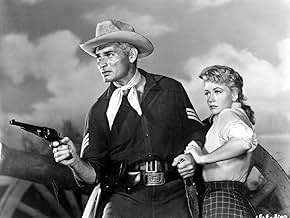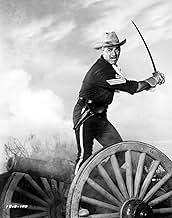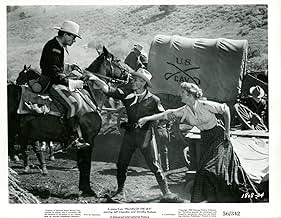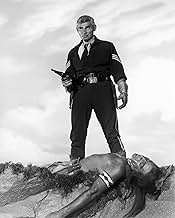VALUTAZIONE IMDb
6,2/10
831
LA TUA VALUTAZIONE
Nel 1868 in Oregon, quando l'esercito viola il trattato costruendo una strada attraverso la riserva, diversi capi delle tribù decidono di unire le loro forze contro i bianchi che sconfinano.Nel 1868 in Oregon, quando l'esercito viola il trattato costruendo una strada attraverso la riserva, diversi capi delle tribù decidono di unire le loro forze contro i bianchi che sconfinano.Nel 1868 in Oregon, quando l'esercito viola il trattato costruendo una strada attraverso la riserva, diversi capi delle tribù decidono di unire le loro forze contro i bianchi che sconfinano.
Recensioni in evidenza
A rather sombre film for veteran director George Marshall, set in Oregon in 1868.
In a well-acted film, Ward Bond is particularly good in a sympathetic role as a preacher; and even Lee Marvin is permitted a touching scene as one of the troop.
In a well-acted film, Ward Bond is particularly good in a sympathetic role as a preacher; and even Lee Marvin is permitted a touching scene as one of the troop.
Pillars of the Sky is an unusual western in that it touches on the role of Christian missionaries in the American West. This film also gives Ward Bond one of the most unusual roles he ever had in his career.
Bond plays a Christian missionary preacher/doctor in the Pacific Northwest region. There is still considerable debate among historians as to what they accomplished. It was thought at the time that the conquered Indian tribes would be more humanely treated under preachers than soldiers. There is no doubt that missionaries, not only in the American west, but in other parts of the world colonized by the west, probably saved indigent peoples from some acts of barbarism.
Whether though, even with the best of intentions, they had the right to destroy a culture is very much open to debate. And Bond is a man with the best of intentions even as he baptizes the Indians giving them names found in the Bible.
One Indian who isn't having any of it is Michael Ansara who's rousing all the tribes to resist the building of a new army post in their territory. But Colonel Willis Bouchey has his orders and Bond is caught in the middle.
Another trio caught in the middle is Captain Keith Andes, his wife Dorothy Malone, and Sergeant Jeff Chandler who Malone was previously engaged to. Malone and Olive Carey are captured by Ansara's bunch and Chandler rescues them. This little romantic subplot is exactly what the cavalry doesn't need as Ansara's band is on the hunt for them.
Pillars of the Sky was filmed on location in the Pacific Northwest and the photography is first rate. And the Indian attacks are well staged by some very smart Indians. Ansara is a cunning and ruthless foe.
It also succeeds in making you admire the courage of our cavalry in carrying out their orders though in fact they are in clear treaty violation. One of the best roles in the film is that of Lee Marvin, an army veteran from the Civil War who is giving the green troops some lessons for survival in a hurry.
I did find it a bit much the end Jeff Chandler has in store for him and I think most viewers will also. As Chandler said, Bond may have given the Indians the priceless gift of his God, but was the cost worth it?
Bond plays a Christian missionary preacher/doctor in the Pacific Northwest region. There is still considerable debate among historians as to what they accomplished. It was thought at the time that the conquered Indian tribes would be more humanely treated under preachers than soldiers. There is no doubt that missionaries, not only in the American west, but in other parts of the world colonized by the west, probably saved indigent peoples from some acts of barbarism.
Whether though, even with the best of intentions, they had the right to destroy a culture is very much open to debate. And Bond is a man with the best of intentions even as he baptizes the Indians giving them names found in the Bible.
One Indian who isn't having any of it is Michael Ansara who's rousing all the tribes to resist the building of a new army post in their territory. But Colonel Willis Bouchey has his orders and Bond is caught in the middle.
Another trio caught in the middle is Captain Keith Andes, his wife Dorothy Malone, and Sergeant Jeff Chandler who Malone was previously engaged to. Malone and Olive Carey are captured by Ansara's bunch and Chandler rescues them. This little romantic subplot is exactly what the cavalry doesn't need as Ansara's band is on the hunt for them.
Pillars of the Sky was filmed on location in the Pacific Northwest and the photography is first rate. And the Indian attacks are well staged by some very smart Indians. Ansara is a cunning and ruthless foe.
It also succeeds in making you admire the courage of our cavalry in carrying out their orders though in fact they are in clear treaty violation. One of the best roles in the film is that of Lee Marvin, an army veteran from the Civil War who is giving the green troops some lessons for survival in a hurry.
I did find it a bit much the end Jeff Chandler has in store for him and I think most viewers will also. As Chandler said, Bond may have given the Indians the priceless gift of his God, but was the cost worth it?
Near the Oregon Trail in what is now southeastern Washington and northeastern Oregon, tribal leaders are upset by the movements of a new cavalry officer and his troops, which break the treaty. An established First Sergeant whom the Indians trust (Chandler) tries to keep the peace, but war is inevitable. Lee Marvin is on hand as a young sergeant while Michael Ansara plays a hostile chief.
"Pillars of the Sky" (1956) came in the tradition of John Ford's Cavalry Trilogy from 1948-1950 and the ensuing "Warpath," as well "The Last Frontier" (aka "Savage Wilderness"). While it's arguably just as worthwhile as the Cavalry Trilogy in its own unique way, it's not as compelling as the other two.
Some of the key actors playing American Indians are Lebanese, Latino, Tennessean, and a New Yorker, but one is a Kickapoo and there are some other genuine Indian peripherals. Overall, their depiction is well done. Meanwhile Chandler's character is supposed to be an alcoholic, but he doesn't look or act like a typical functioning alcoholic, such as Ulysses S. Grant. Actually, Jeff is towering and god-like as the commanding noncommissioned officer, despite his drinking.
There's a love triangle thrown into the mix involving Chandler, Dorothy Malone and Keith Andes. While this might cause some eye-rolling, I'm pretty sure there were one or two love triangles during the decades of the Indian Wars. Speaking of rolling your eyes, there's some lame (and incongruous) comedy involving a raw recruit and his horse, but it's so minor it can be overlooked.
The best thing about this Western is the superb authentic locations and the muscular action. But I also liked the emphasis on Christianity with Ward Bond playing the missionary-physician. You'd never see this today, of course, as it's a great sin now to show Christianity in a positive light. Get real.
It runs 1 hour, 26 minutes (the version I watched), and was shot in northeast Oregon at Joseph and nearby Wallowa Lake, as well as LaGrande, which is to the west of there. Studio scenes were done at Universal Studios in the Los Angeles area.
GRADE: B-
"Pillars of the Sky" (1956) came in the tradition of John Ford's Cavalry Trilogy from 1948-1950 and the ensuing "Warpath," as well "The Last Frontier" (aka "Savage Wilderness"). While it's arguably just as worthwhile as the Cavalry Trilogy in its own unique way, it's not as compelling as the other two.
Some of the key actors playing American Indians are Lebanese, Latino, Tennessean, and a New Yorker, but one is a Kickapoo and there are some other genuine Indian peripherals. Overall, their depiction is well done. Meanwhile Chandler's character is supposed to be an alcoholic, but he doesn't look or act like a typical functioning alcoholic, such as Ulysses S. Grant. Actually, Jeff is towering and god-like as the commanding noncommissioned officer, despite his drinking.
There's a love triangle thrown into the mix involving Chandler, Dorothy Malone and Keith Andes. While this might cause some eye-rolling, I'm pretty sure there were one or two love triangles during the decades of the Indian Wars. Speaking of rolling your eyes, there's some lame (and incongruous) comedy involving a raw recruit and his horse, but it's so minor it can be overlooked.
The best thing about this Western is the superb authentic locations and the muscular action. But I also liked the emphasis on Christianity with Ward Bond playing the missionary-physician. You'd never see this today, of course, as it's a great sin now to show Christianity in a positive light. Get real.
It runs 1 hour, 26 minutes (the version I watched), and was shot in northeast Oregon at Joseph and nearby Wallowa Lake, as well as LaGrande, which is to the west of there. Studio scenes were done at Universal Studios in the Los Angeles area.
GRADE: B-
I am not a huge fan of westerns but from time to time I don't mind watching some on TV. The problem is that most of the time the plots are all very similar... originality is not a trademark of the genre. Yet PILLARS OF THE SKY was a bit different. Let's see why.
In 1868 Oregon various Indian tribes are confined in a reserve built by Doctor Holden (Ward Bond) and Sergeant Emmet Bell (Jeff Chandler) has to make sure that there is always peace. However, some transfert of US Army Weapons makes chief Kamiakin (Michael Ansara) very suspicious and they attack the Army. Unfortunately appeals for a truce don't work, and after Kamiakin is killed by one of his own the other chiefs and Bell will do whatever is necessary for keeping the peace.
The acting was very good for a Western. Jeff Chandler was very good and believable as an Army Sergeant that is very concerned about keeping the peace between the Army and the Indians. Dorothy Malone gives a great performance other than still looking gorgeous, and the cast is chock full of many familiar faces of those years: Martin Milner, Lee Marvin, Willis Bouchey, Philip Carey and a scene-stealing Michael Ansara are all pretty entertaining. The Oregon scenery was great and makes you want to go on vacation there, and the soundtrack fit the movie's spirit very well.
If you are a die hard western fan don't miss it if you haven't seen it, but for those who watch them from time to time it's solid and entertaining... what more you can ask?
In 1868 Oregon various Indian tribes are confined in a reserve built by Doctor Holden (Ward Bond) and Sergeant Emmet Bell (Jeff Chandler) has to make sure that there is always peace. However, some transfert of US Army Weapons makes chief Kamiakin (Michael Ansara) very suspicious and they attack the Army. Unfortunately appeals for a truce don't work, and after Kamiakin is killed by one of his own the other chiefs and Bell will do whatever is necessary for keeping the peace.
The acting was very good for a Western. Jeff Chandler was very good and believable as an Army Sergeant that is very concerned about keeping the peace between the Army and the Indians. Dorothy Malone gives a great performance other than still looking gorgeous, and the cast is chock full of many familiar faces of those years: Martin Milner, Lee Marvin, Willis Bouchey, Philip Carey and a scene-stealing Michael Ansara are all pretty entertaining. The Oregon scenery was great and makes you want to go on vacation there, and the soundtrack fit the movie's spirit very well.
If you are a die hard western fan don't miss it if you haven't seen it, but for those who watch them from time to time it's solid and entertaining... what more you can ask?
Slow-paced story gets off to a ponderous start with too much talk and too little action, with only some gorgeous scenery for eye comfort. The fault seems to be George Marshall's sluggish direction of a uniformly bland cast.
All of the actors go through their paces in rather standard roles, including JEFF CHANDLER, KEITH ANDES, WARD BOND and LEE MARVIN and for a western that promises some action when the plot thickens, it's a good half-hour before the conflict between cavalry and Indians provides any thrills.
DOROTHY MALONE has the only substantial female role, as a woman no longer in love with her husband. In make-up and hairstyle, she looks and acts more as though she's a woman of modern times rather than frontier days. The romantic triangle (Malone, Chandler, Andes) is a weak one.
The big set piece is the Indian attack that occurs an hour into the film and wipes out most of the command. It's well staged and vigorously mounted for western action. But it comes too late to alter the slow pacing of most of the story which is either Marshall's or the scriptwriter's fault.
A minor quibble: All of the night scenes have a soundstage look to them, in sharp contrast to all the daytime locations.
Summing up: Lackluster western needed the John Ford touch from George Marshall, with Lee Marvin and his Irish accent less than credible in the sort of supporting role Victor McLaglen usually played. Nothing more than average.
All of the actors go through their paces in rather standard roles, including JEFF CHANDLER, KEITH ANDES, WARD BOND and LEE MARVIN and for a western that promises some action when the plot thickens, it's a good half-hour before the conflict between cavalry and Indians provides any thrills.
DOROTHY MALONE has the only substantial female role, as a woman no longer in love with her husband. In make-up and hairstyle, she looks and acts more as though she's a woman of modern times rather than frontier days. The romantic triangle (Malone, Chandler, Andes) is a weak one.
The big set piece is the Indian attack that occurs an hour into the film and wipes out most of the command. It's well staged and vigorously mounted for western action. But it comes too late to alter the slow pacing of most of the story which is either Marshall's or the scriptwriter's fault.
A minor quibble: All of the night scenes have a soundstage look to them, in sharp contrast to all the daytime locations.
Summing up: Lackluster western needed the John Ford touch from George Marshall, with Lee Marvin and his Irish accent less than credible in the sort of supporting role Victor McLaglen usually played. Nothing more than average.
Lo sapevi?
- QuizBetween takes, Ward Bond argued with Lee Marvin that the US should attack the Soviet Union because of what Bond claimed to be the Communist threat. Marvin, an ex-Marine who served in World War II, was wounded in the fighting on Saipan against the Japanese,. He asked Bond--who had never spent a day in the military due to epilepsy, --how he spent the war. Bond had no real reply, and Marvin pointed out that the only thing Bond knew about war was what he pretended to fight on studio back lots.
- BlooperThe cavalry had a Red Cross wagon. The American Red Cross was not founded until 1881.
- ConnessioniFeatured in Cuba (1979)
- Colonne sonoreBugle Calls
(uncredited)
Composer unknown
I più visti
Accedi per valutare e creare un elenco di titoli salvati per ottenere consigli personalizzati
Dettagli
Botteghino
- Lordo Stati Uniti e Canada
- 1.500.000 USD
- Tempo di esecuzione
- 1h 35min(95 min)
- Proporzioni
- 2.35 : 1
Contribuisci a questa pagina
Suggerisci una modifica o aggiungi i contenuti mancanti




































